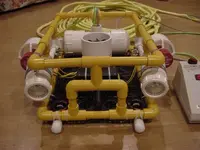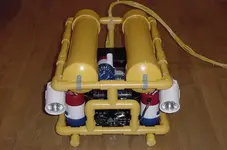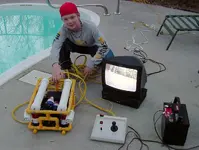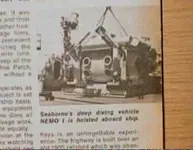T S
The depth of oil filled thrusters is "full ocean depth" which in real terms is 28000 ft the problems arise with 3 main things:
1) the absolute removal of all air from casing
2) the distortion of the outer shell material.
3) the thrusters must run continuously or the oil needs to be heated as it tends to go a little like molasses when the temp drops. (this is not detrimental to the actual thruster itself just its performance and amperage peaks on start up)
The 600ft is at what pressure most plastics / pvc start to take on distortion and the characteristics and properties of the material can alter to such an extent it can have catastrophic failure. A better material here is Delrin.
This same principle can be adopted for umbilical and electrical housings on the rov. In order for them to be pressure proof to say 1000ft the housing would need to be substantial and usually cylinder shaped with capped ends (these are awkward for building components into) being substantial means also being heavy (using aluminum or titanium cylinder walls can cut down on wall thickness but the downside is the end caps which add all the weight) to counter this weight they are usually constructed larger to add buoyancy to balance it all out (syntactic foam can also be used but is still not as efficient as solid open space buoyancy) Anyhow before I ramble off into the ROV/SUBMERSIBLE nightmare of weight vs buoyancy I will go on with the explanation:
Umbilical termination boxes and electrical (not electronic) junction boxes can now be a simple off the shelf watertight electrical box (a good make like Klockner Mueller etc which also has a clear front ) oil filled with a simple hydraulic compensator attached or the fill hose can be say 1 inch dia and mounted on top of the box (use clear soft pvc hose about 2 ft in length this hose will act like the hydraulic compensator it will allow the external pressure to act upon the oil keeping both internal and external equalized.
The hydraulic compensator is nice as it allows expansion of the oil if you are working in warmer shallow waters ( anything can be used for this the principle is a half filled syringe allowing the water pressure to push down on the plunger thus forcing oil into box and equalizing pressures, if the temperature increases then as the oil expands it pushes the plunger out) oh yes the position of the plunger is usually half way I have come across many different types of homemade compensators and they all appear to do the job.
So by using this method we have simplified the umbilical termination box and all electrical outlets. It also allows you to use a less expensive or even a homemade umbilical as the oil is forced up the umbilical the deeper you go (you use a standard outdoors nylon cable compression fitting to attach umbilical to box) The same goes for all other connections Thrusters, lights etc. (here I want to point out that it is always best to run higher voltage and step down on the vehicle as it keeps umbilical size down which results in cost savings and easier tether management for both yourself and the vehicle)
If you wish to keep a watertight connection from your umbilical to the vehicle and dive it to anything over 400ft then you need to spend a lot of money on the umbilical or it will simply collapse at the vehicle end . An interesting test (if you don?t have a test chamber handy) is to terminate the end of the umbilical you plan on using with epoxy 50/50 two part cold mix ( just use a larger piece of hose pipe or something for the mold ) it must go up the umbilical at least 6 inches and extend 2 inches below then once set lower the umbilical to your working depth and see the results any non custom cables will just compress to the extent of destruction .
Regarding cameras, lights and housings I will post something tomorrow in more detail if you wish, including how to make your own through hull waterproof connections as these are usually a killer when you have to purchase and using standard $ 75 echo sounders as altimeters. In the meantime here is a link to a site with pressure housing software programs ( they are costly but they have a demo you can play with)
http://www.deepsea.com/underpressure/
Another good pressure vessel site is :
http://www.prevco.com/
Have a look around and get ideas on how you would make your own its really not that difficult.
Hope any of this helps or makes sense.






 .
.

